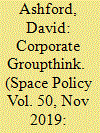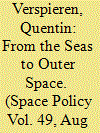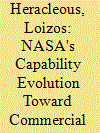|
|
|
Sort Order |
|
|
|
Items / Page
|
|
|
|
|
|
|
| Srl | Item |
| 1 |
ID:
169356


|
|
|
|
|
| Summary/Abstract |
This article describes a launch vehicle development roadmap that uses only proven technology and that could lead to a thousand-fold reduction in the cost of sending people to orbit within about 15 years. It could reduce the cost of the first lunar base by very approximately ten times. This would clearly revolutionise spaceflight and create a new space age. The roadmap involves a combination of full reusability, aeroplane-like vehicle design and high traffic levels, especially from space tourism, to provide economies of scale. This line of development could have started some fifty years ago, and the failure to do this has led to a corporate groupthink that is probably now the biggest obstacle to progress.
|
|
|
|
|
|
|
|
|
|
|
|
|
|
|
|
| 2 |
ID:
169351


|
|
|
|
|
| Summary/Abstract |
Data collection and information sharing are at the core of any traffic control system. In particular, Maritime Situational Awareness—restricted in this article to one of its main components, the automatic identification system (AIS)—and Space Situational Awareness (SSA) are the backbones of, respectively, maritime and space traffic control frameworks. While the AIS has been initiated by civil authorities for civil purposes and is now being adopted by navies around the world, SSA, originally developed by the military to protect national security assets in outer space is progressively transferred to civil actors. This article shows how and why the intrinsically different nature and history of maritime and space traffics generated a totally reverse approach towards information and responsibility sharing in support to traffic control, while presenting current proposals for the evolution of SSA.
|
|
|
|
|
|
|
|
|
|
|
|
|
|
|
|
| 3 |
ID:
169355


|
|
|
|
|
| Summary/Abstract |
Space collaboration has become quite common in recent years, thanks in large part to the high cost of such endeavors. This article reviews a rather early example of space collaboration, the partnership between China and the United States (U.S.) during the period 1978–2000. The collaboration began with general discussions and grew to include the use of Chinese rockets to launch U.S. satellites into orbit. We discuss where this collaboration worked successfully, where it did not, and why it ended. The ultimate collapse of the collaboration highlights the complexity of joint international projects for the factors that caused failure included the Cold War dynamic of geopolitical competition for international military and economic dominance and its continuance into the 1990s in Sino-U.S. relations; the domestic political landscape in both countries, which included bitter Democratic-Republican party rivalries in the U.S. and the top-down centralized decision-making system in China with significant influence by the People's Liberation Army; and the economic interests of U.S. aerospace contractors. But the issue that most directly ended cooperation in space was U.S. concerns about the transfer to China of sensitive satellite and rocket technology. For this history, we draw upon existing English language materials and Chinese language sources that have not been available to English-speaking scholars to illuminate China's involvement in this collaboration. We also describe subsequent Chinese space activities to pursue additional collaboration and offer comments about possible future Sino-U.S. space cooperation, against this backdrop of long-running national security concerns about transfers of knowledge and technology.
|
|
|
|
|
|
|
|
|
|
|
|
|
|
|
|
| 4 |
ID:
169352


|
|
|
|
|
| Summary/Abstract |
We discuss how the space industry moved from a government dominated field to a commercially driven field. In the context of this industry shift, we explore how NASA's capabilities developed from its early hierarchical model to the intergovernmental and then commercial network models. We refer in particular to NASA's organizational, cultural, relational, and technological capabilities. These developments over time suggest that these are dynamic capabilities that respond to the demands of the external environment and to mission imperatives.
|
|
|
|
|
|
|
|
|
|
|
|
|
|
|
|
| 5 |
ID:
169353


|
|
|
|
|
| Summary/Abstract |
This study tests the congruence between public opinion toward funding US space exploration and previously theorized rationales to justify space activities and examines how those motivations differ by political party and how they vary from 1973 to 2016. General Social Survey data are used to measure correlations between space spending preferences and other spending categories that proxy proposed rationales, with mixed effects and ordinal logit regressions. Consistent with the scientific discovery rationale, support for funding space correlates with positive attitudes toward science. During the Cold War, a national security frame prevailed: Space and military preferences were correlated, with “hawks” supporting defense and space spending and “doves” opposing both. After the Cold War, Republicans continue to show strong space-military correlation, but for Democrats, space funding support now correlates with environmental protection preferences and not their military spending views. Both parties show slight negative correlations between space and social welfare spending. Overall partisan differences in funding preferences have not greatly increased, but diverging motivations have implications for future space politics.
|
|
|
|
|
|
|
|
|
|
|
|
|
|
|
|
| 6 |
ID:
169354


|
|
|
|
|
| Summary/Abstract |
Owing to recent changes in the structure of the aerospace sector and its relationship to government, the landscape of the space industry is now experiencing the emergence of a commercialization paradigm. Private space endeavors may soon be able to target the novel market segments of space research and exploration, space resources utilization, and human access to space and to further stimulate the growth of a new space economy. Thus, the interdisciplinary field of planetary protection has to keep abreast of these advances to avoid unnecessary complications that might hinder the useful reinvigoration of economic interest in the space sector. Planetary protection is defined as a set of guidelines that aim to prevent the forward contamination of celestial bodies with biological material from Earth and the backward contamination of the terrestrial biosphere with extraterrestrial biological material. The possession of the technical capabilities for access to space by more than one private entity is now formulating the public perception of a so-called “Mars Race” that raises significant questions with respect to potential forward and backward contamination issues. This work outlines an environmental economics approach to backward contamination. Specifically, the commercial activities on Mars that may pose backward contamination risks are those that require the return of people, material, vehicles, or other equipment back to Earth, such as the potential business cases of Mars tourism and commercial sample return. Although these activities do not seem to pose a realistic planetary protection risk at present, it would be prudent to consider them during policy-making. Earth-return missions from Mars are expected to generate vigorous public interest worldwide in the environmental, health, and safety risks related to a potential backward contamination incident. As these kinds of missions also involve a post-reentry phase on Earth for the recovery, transfer, reception, and distribution of the samples and for the handling of returned people and equipment, quarantine issues that have not been raised since the Apollo era may become relevant again. In the case of this kind of post-reentry commercial activities, various jurisdictions and laws pertain to the matter. However, public perception will play a key role, as it has done in other industrial development projects with a need for social responsibility. Drawing from terrestrial analogies of siting noxious facilities and other development cases with strong environmental justice characteristics, this work will explore the application of environmental economics as an approach to equitably balance the benefits and costs of future commercial space endeavors with a backward contamination risk.
|
|
|
|
|
|
|
|
|
|
|
|
|
|
|
|
|
|
|
|
|